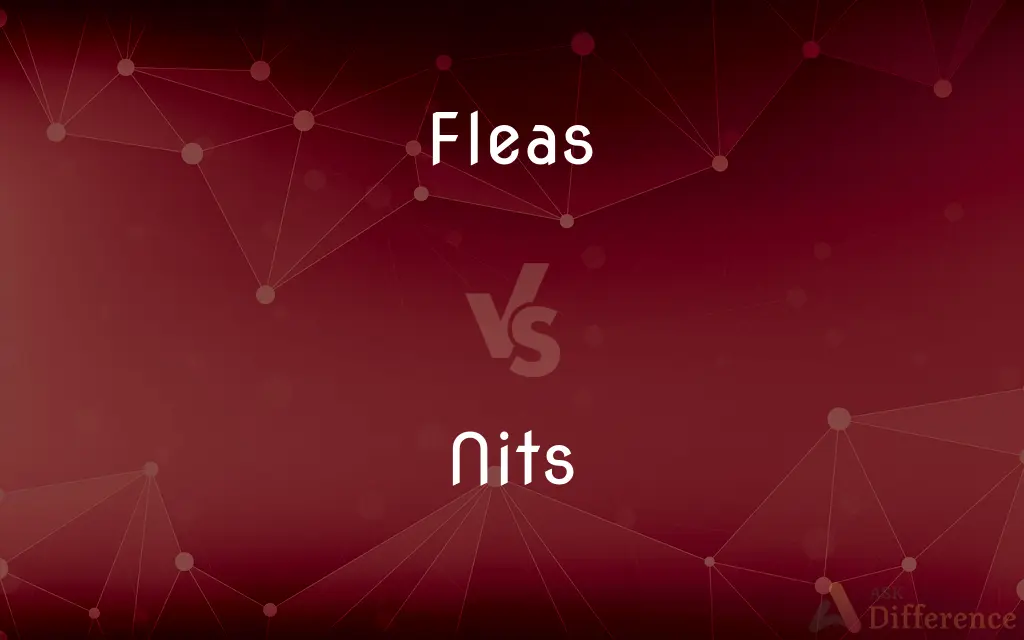Fleas vs. Nits — What's the Difference?
By Tayyaba Rehman — Published on November 4, 2023
Fleas are tiny, jumping parasites that bite and feed on blood; Nits are the eggs of lice, often found attached to hair shafts.

Difference Between Fleas and Nits
Table of Contents
ADVERTISEMENT
Key Differences
Fleas are minuscule insects known for their incredible jumping ability. They feed on the blood of mammals and birds, causing itching and discomfort. Nits, on the other hand, are not insects in their own right but are the eggs of head lice.
When discussing Fleas, it's crucial to note their life cycle, which consists of the egg, larva, pupa, and adult stages. The adult fleas are responsible for the biting and subsequent itching. Nits are just one stage in the life cycle of lice, preceded by the actual louse that, when matured, feeds on blood, much like fleas.
Both Fleas and Nits are often associated with discomfort and are unwelcome pests. While fleas infest various animals, including household pets like cats and dogs, nits are primarily found in human hair, indicating a lice infestation. It's important not to confuse nits with dandruff or other scalp debris.
Fleas can be a concern for both pet owners and those without pets, as they can infest homes. Dealing with an infestation often requires treating the environment and the host animal. Nits, while limited to human hair, require careful removal and treatment to prevent the lice from hatching and multiplying.
In essence, while both fleas and nits can be nuisances, they originate from different pests, have different lifecycles, and require distinct methods of treatment and eradication.
ADVERTISEMENT
Comparison Chart
Nature
Insect (Parasite)
Egg of lice
Infestation Site
Animals & surroundings
Human hair
Lifecycle
Egg, larva, pupa, adult
Egg stage of lice
Appearance
Tiny, dark, jumping bugs
Tiny, oval, often yellowish or white
Treatment
Treat host & environment
Removal from hair & lice treatment
Compare with Definitions
Fleas
Known for their remarkable jumping abilities.
The fleas jumped from the carpet onto the dog's fur.
Nits
Eggs laid by head lice.
Upon inspection, the nurse found nits in the child's hair.
Fleas
Parasites infesting mammals and birds.
Birds nesting nearby can sometimes introduce fleas into homes.
Nits
Indicators of a lice infestation.
The presence of nits means that lice treatment is necessary.
Fleas
Tiny insects that feed on blood.
The cat was scratching incessantly due to the fleas.
Nits
Tiny and oval in shape.
Distinguishing between dandruff and nits can sometimes be challenging.
Fleas
Cause itching and discomfort.
After the hike, she felt itchy and discovered fleas on her socks.
Nits
Attach firmly to hair shafts.
Using a fine-toothed comb helps in removing nits from the hair.
Fleas
Have a four-stage lifecycle.
Understanding the lifecycle of fleas is crucial for effective eradication.
Nits
Typically yellowish or white.
The nits appeared as tiny white dots against her dark hair.
Fleas
Any of various small, wingless, bloodsucking insects of the order Siphonaptera that are parasitic on mammals and birds and can jump long distances.
Nits
The egg of certain parasitic insects, especially a head louse.
Fleas
Any of various small crustaceans that resemble or move like fleas, such as the water flea.
Nits
A unit of luminance equal to one candela per square meter, measured perpendicular to the rays of the source.
Fleas
Plural of flea
Nits
Plural of nit
Fleas
Infl of flea
Common Curiosities
Do both fleas and nits feed on blood?
Adult fleas feed on blood, but nits are just the egg stage of lice and don't feed.
What are fleas?
Fleas are tiny, blood-feeding insects that infest mammals and birds.
How can I differentiate between nits and dandruff?
Nits are oval and firmly attached to hair, while dandruff is flaky and easily brushed off.
How long does it take for nits to hatch?
Typically, nits hatch in 7 to 9 days.
Are there specific combs for nit removal?
Yes, fine-toothed combs are designed specifically for nit and lice removal.
What are nits?
Nits are the eggs of head lice, typically found attached to human hair shafts.
If I find nits, does it mean I have an active lice infestation?
Not necessarily. Nits are eggs, but finding live lice indicates an active infestation.
Can fleas infest humans directly?
While fleas primarily infest animals, they can bite humans when present in their environment.
How can I prevent flea infestations in my home?
Regularly treat pets with flea preventatives and keep your living environment clean.
What's the lifecycle of a flea?
Fleas go through four stages: egg, larva, pupa, and adult.
Can fleas transmit diseases?
Yes, fleas can transmit various diseases, including bubonic plague and tapeworms.
Share Your Discovery

Previous Comparison
Simple Harmonic Motion vs. Periodic Motion
Next Comparison
Oxford Shirt vs. Dress ShirtAuthor Spotlight
Written by
Tayyaba RehmanTayyaba Rehman is a distinguished writer, currently serving as a primary contributor to askdifference.com. As a researcher in semantics and etymology, Tayyaba's passion for the complexity of languages and their distinctions has found a perfect home on the platform. Tayyaba delves into the intricacies of language, distinguishing between commonly confused words and phrases, thereby providing clarity for readers worldwide.











































